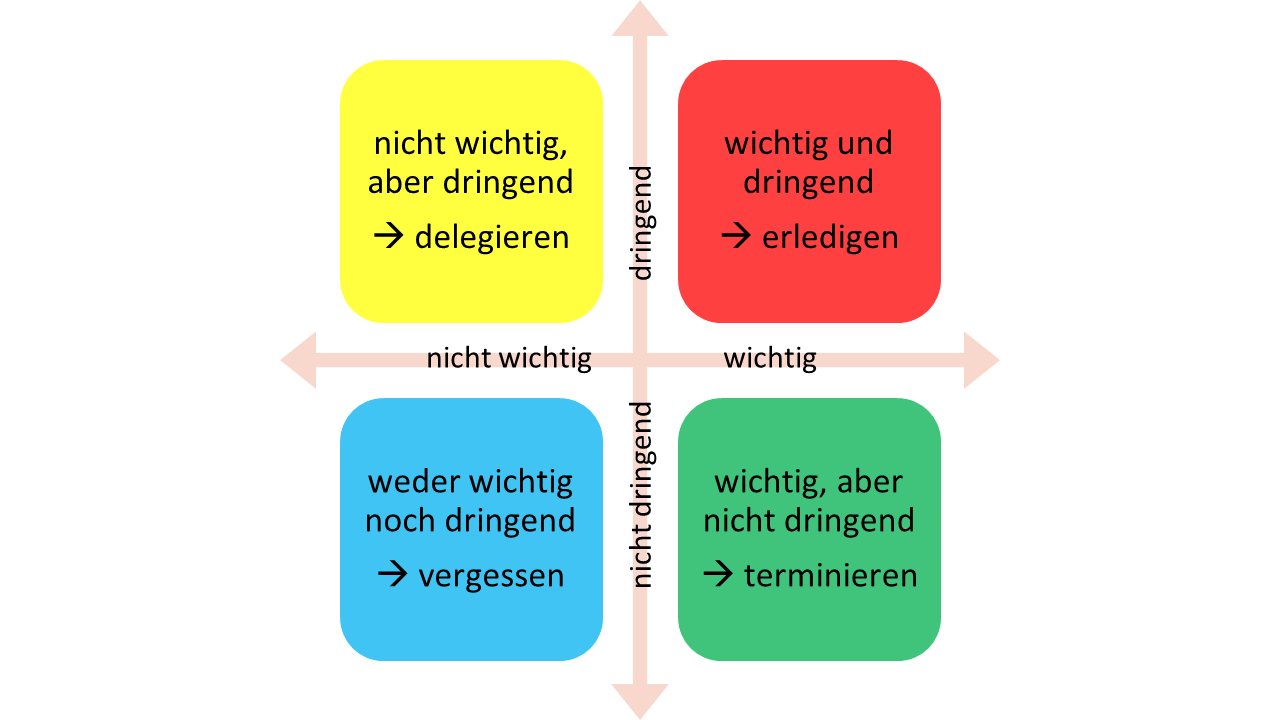Tasks And Goals In Harmony
With this procedure you keep the overview and concentrate on the essentials!

Every day has 24 hours. During these 24 hours, appointments have to be kept, agreements made, professional and private tasks completed and in between we would also like to have time for free time, breaks, regeneration and sleep. There are also things that we would like to achieve over time. How are you supposed to reconcile all of this? What do we need in order to complete all our tasks and achieve our goals?
Define Tasks
We start with a classic TODO list in which we write down all our tasks - no matter when they are scheduled to be completed.
|
Tasks &
Goals |
|
Task
1 |
|
Task 2 |
|
Task
3 |
|
Task 4 |
|
Task
5 |
Schedule Tasks
We assign the latest possible completion date to our tasks. All tasks to which we cannot assign a completion date are placed in a separate list.
|
Tasks |
|
|
Scheduled |
Not Scheduled |
|
Task 1 – Today |
Task 2 |
|
Task
3 – Today |
Task
6 |
|
Task 4 – 22.05. |
Task 7 |
|
Task
5 – 01.07. |
Task
8 |
Label Recurring Tasks
Tasks that are scheduled regularly are now provided with the appropriate repetition rate (e.g. always on the 1st, every 2nd Friday, every day, etc.).
|
Tasks |
||
|
Scheduled |
Not Scheduled |
|
|
|
Zyklus |
|
|
Task
1 – Today |
Daily |
Task
2 |
|
Task 3 – 01.06. |
Every 1st of the month |
Task 6 |
|
Task
4 – Today |
Every week Thursday |
Task
7 |
|
Task 5 – 22.05. |
|
Task 8 |
|
Task
9 – 01.07. |
|
|
|
Task 10 – Today |
|
|
|
Task
11 – 13.05. |
|
|
Daily Categorization And Prioritization
With the previous procedure, we already have a time prioritization and know what needs to be done today, tomorrow, soon and at some point.
Now we also want to categorize our tasks according to their importance. To do this, we transfer all of our tasks to the Eisenhower matrix. With their help, we can determine anew every day what is going on and how we are dealing with our tasks.
The Eisenhower Principle
With the help of the Eisenhower principle, tasks can be meaningfully collected and prioritized. With this time management method, tasks are categorized according to urgency and importance. All tasks are collected in a matrix that includes the following four areas.
- important and urgent
- not important but urgent
- important but not urgent
- neither important nor urgent
A further prioritization can be carried out within the individual categories, since it is usually not possible and does not make sense to complete several tasks at the same time.

1. Important And Urgent
Tasks in this area of the matrix should be done immediately and by yourself. From our ready-made list, we classify here all the tasks that we have to do ourselves today.
2. Not Important But Urgent
Urgent but not important tasks should – if possible – be delegated. If delegation is not possible, these tasks must be completed after the tasks that are important and urgent.
3. Important But Not Urgent
Tasks in this area of the matrix should be provided with a specific completion date and then be completed by yourself. This is where we can push any tasks that we haven't scheduled for today.
4. Neither Important Nor Urgent
For tasks in this area of the matrix, it must be decided in each case whether the task will become urgent or important in the future or not. In the first case, the task is "forgotten" until its status changes. In the second case, the task should simply be deleted. Here we classify all tasks to which we have not assigned a completion date.
Consider Goals
So far we've created an Eisenhower Matrix that includes all of our unique and recurring tasks. But people not only have tasks, they also have goals. We also want to (indirectly) incorporate these into our matrix.
What Do My Goals Have To Do With My Tasks?
You may be wondering what is meant by goals and tasks and what the difference is. A goal describes a state that we want to bring about. Examples of goals could be:
- climb a mountain
- lose 10 pounds
- parachute jump
- marry
- earn €10,000 monthly
What all goals have in common is that several tasks must be completed in order to achieve them. Goals help us remember why we do or don't do certain things.
Collect Goals
In the first step, we collect all our goals, no matter what kind of goal we want to achieve. The result should look similar to our TODO list from the beginning. Setting a specific goal increases the probability of achieving it. The SMART method is therefore ideal for defining goals.
Time Goals
In the next step, we determine for all of our goals whether they are short-term, medium-term, long-term or life goals. The classification is based on the time horizon that we set ourselves for achieving the goal.
- short term: <= 1 year
- medium term: <= 5 years
- long-term: <= 10 years
- life goals: > 10 years
We should regularly review our list of goals to see if there have been any changes or circumstances. This too could be incorporated as a recurring task in the Eisenhower matrix.
|
Goals |
|||
|
Short Term (ST) <= 1 Year |
Medium Term (MT) <= 5 Years |
Long Term (LT) <= 10 Years |
Life Goals > 10 Years |
|
ST Goal 1
ST Goal 2
ST Goal 3
ST Goal 4 |
MT Goal 1 MT Goal 2 MT Goal 3 |
LT Goal
1 LT Goal
2 LT Goal
3 LT Goal
4 |
Life Goal 1
Life Goal 2
Life Goal 3 |
Establish A Relationship Between Goals And Tasks
In order to actually achieve our goals, we should make sure that there is at least one scheduled task per goal in our list at all times that will bring us closer to achieving our goal. For example, if our goal is to lose 20 pounds within the next 12 months, there could be a daily task for exercise on our task list.
Conclusion
We looked at how to structure, organize and prioritize our tasks and goals.
Of course you can go further and plan your time on an hourly basis. However, experience has shown that this often does not work because something always comes up, priorities change during the day or you are simply not as efficient as usual.
However, a lot has already been achieved with the procedure described:Bewusstsein für die eigenen Ziele
- increase the likelihood of achieving your goals
- sorting of all tasks according to importance and urgency
- recommendation for action for each individual task
- changeable and expandable list of tasks at any time
- one-time effort, lasting benefit
- recurring and more complex tasks can also be displayed
How do you balance your tasks and goals?